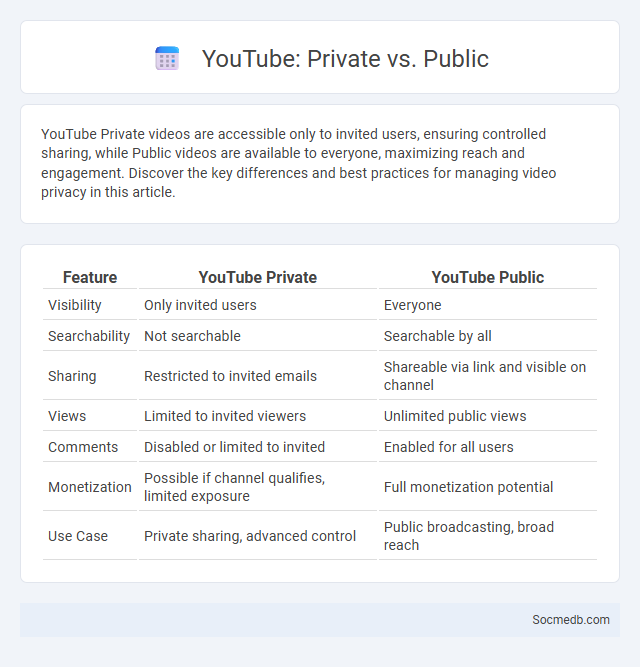
Photo illustration: YouTube Private vs Public
YouTube Private videos are accessible only to invited users, ensuring controlled sharing, while Public videos are available to everyone, maximizing reach and engagement. Discover the key differences and best practices for managing video privacy in this article.
Table of Comparison
| Feature | YouTube Private | YouTube Public |
|---|---|---|
| Visibility | Only invited users | Everyone |
| Searchability | Not searchable | Searchable by all |
| Sharing | Restricted to invited emails | Shareable via link and visible on channel |
| Views | Limited to invited viewers | Unlimited public views |
| Comments | Disabled or limited to invited | Enabled for all users |
| Monetization | Possible if channel qualifies, limited exposure | Full monetization potential |
| Use Case | Private sharing, advanced control | Public broadcasting, broad reach |
Understanding YouTube Video Privacy Settings
YouTube video privacy settings allow you to control who can view your content by choosing between Public, Unlisted, or Private options. Public videos are accessible to anyone, Unlisted videos only appear to those with the direct link, and Private videos are restricted to specific users you invite via their email addresses. Understanding these settings helps you manage your video exposure and protect your privacy effectively.
What is a Public YouTube Video?
A public YouTube video is a type of content on the platform that anyone can search for, view, and share without restrictions. This setting maximizes visibility and engagement, allowing creators to reach a broad audience and improve channel growth through organic discovery. Public videos contribute significantly to YouTube's algorithm by generating higher watch time, likes, comments, and shares, which boost video ranking in search results and recommendations.
What is an Unlisted YouTube Video?
An unlisted YouTube video is a video that does not appear in public search results, channel listings, or subscriber feeds, making it accessible only via a direct link. This privacy setting allows creators to share content selectively with specific viewers without broadcasting it to the general public. It differs from private videos by permitting anyone with the link to view the content, streamlining controlled sharing for educational, promotional, or personal purposes.
What is a Private YouTube Video?
A private YouTube video is a type of video upload setting that restricts access exclusively to users who have been explicitly invited by the uploader via their Google accounts. Unlike public or unlisted videos, private videos do not appear in YouTube search results, recommendations, or subscribers' feeds, ensuring maximum confidentiality. This feature is ideal for sharing content with a limited audience, such as friends, family, or team members, without risking unintended public exposure.
Key Differences: Public vs. Private vs. Unlisted Videos
Public videos on social media are accessible to anyone and can be discovered through search engines and platform recommendations, maximizing reach and engagement. Private videos restrict access to specific users or groups, ensuring content remains confidential and controlled, ideal for personal or sensitive sharing. Unlisted videos remain hidden from public search and recommendations but can be accessed by anyone with the direct link, offering a balance between privacy and shareability.
Pros and Cons of Public Videos on YouTube
Public videos on YouTube offer vast exposure, helping you reach millions of viewers worldwide and grow your personal or business brand effectively. However, these videos also expose your content to potential misuse, copyright claims, and unwanted negative comments that can impact your reputation. Balancing visibility with privacy concerns is essential when deciding to share videos publicly on YouTube.
Pros and Cons of Private Videos on YouTube
Private videos on YouTube offer enhanced control over audience access, allowing content creators to share sensitive or exclusive content with selected viewers only. This feature supports privacy and targeted sharing but limits discoverability and engagement, as private videos do not appear in search results or recommendations. Balancing privacy with wider reach remains a critical consideration for creators deciding whether to set videos as private.
Pros and Cons of Unlisted Videos on YouTube
Unlisted videos on YouTube allow you to share content privately with specific viewers without appearing in public search results or recommendations, providing control over audience reach. However, unlisted links can be easily forwarded, potentially exposing your video beyond intended recipients, which raises privacy concerns. This feature balances discreet sharing with limited visibility, but requires caution to maintain your content's exclusivity.
Choosing the Right Privacy Setting for Your Content
Selecting the appropriate privacy settings on social media platforms ensures your content reaches the intended audience while safeguarding your personal information. Adjusting visibility options like public, friends-only, or custom lists maximizes control over who can view and interact with your posts. You can enhance security by regularly reviewing and updating these settings to align with your sharing preferences and privacy needs.
Frequently Asked Questions About YouTube Privacy Options
YouTube offers various privacy settings that control who can view your videos, including Public, Unlisted, and Private options. Your video's privacy level determines its visibility on search engines and whether only selected users can access your content. Understanding YouTube's privacy policies helps you manage your channel's security and user interaction preferences effectively.
 socmedb.com
socmedb.com